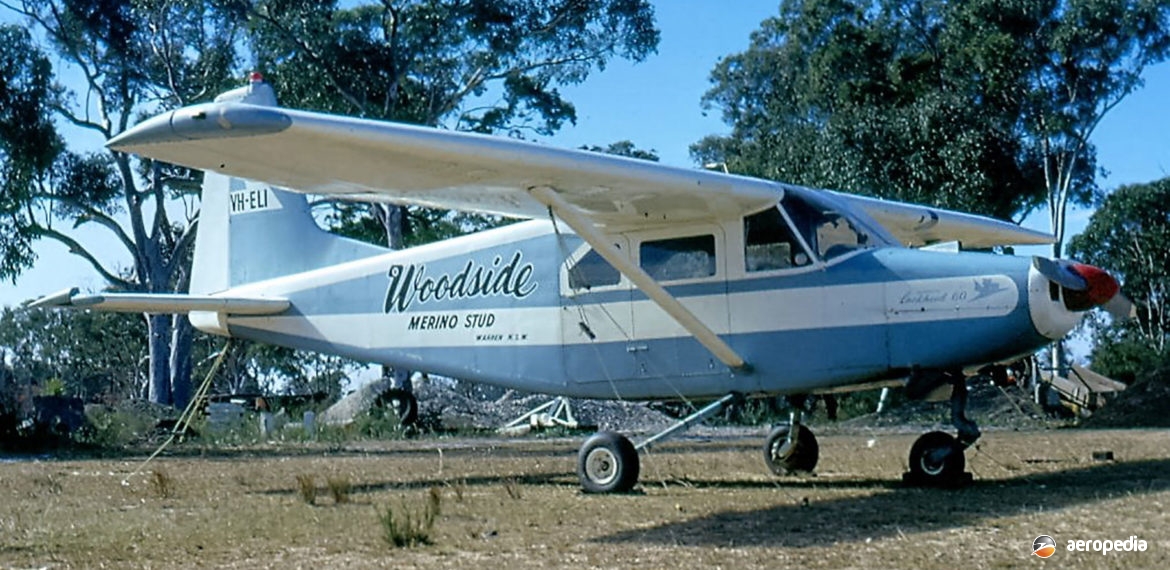Photograph:
Lockheed AL-60 VH-ELI (c/n 11/6156) at Port Macquarie, NSW in July 1973 (David C Eyre)
Country of origin:
United States of America
Description:
Six-seat utility transport
Power Plant:
One 186 kw (250 hp) Continental TSIO-470-R six-cylinder horizontally opposed air-cooled engine
Specifications:
- Wingspan: 11.99 m (39 ft 4 in)
- Length: 8.83 m (28 ft 11½ in)
- Height: 2.76 m (9 ft 0½ in)
- Wing area: 19.51 m² (210 sq ft)
- Max speed at 4,800 m (15,750 ft): 269 km/h (167 mph)
- Max speed at sea level: 238 km/h (148 mph)
- Max cruising speed: 225 km/h (140 mph)
- Stalling speed: 85 km/h (53 mph)
- Economical cruising speed: 209 km/h (130 mph)
- Initial rate of climb: 270 m/min (890 ft/min)
- Service ceiling: 5,210 m (17,100 ft)
- Range with max fuel: 885 km (550 miles)
- Fuel capacity: 216 litres (48 Imp gals)
- Take-off run: 196 m (645 ft)
- Take-off distance to 15 m (50 ft): 335 m (1,100 ft)
- Landing distance from 15 m (50 ft): 258 m (845 ft)
- Empty weight: 918 kg (2,024 lb)
- Max payload: 653 kg (1,1400 lb)
- Loaded weight: 1,602 kg (3,532 lb)
History:
The Lockheed 60, also known as the LASA-60, the CL-402, and the Santa Maria, was designed and built by Lockheed’s Georgia Division to a specification prepared by General Juan Azcarate of Mexico. Flown for the first time on 15 September 1959, it was intended that the type would be produced in other countries, studies having indicated that the American domestic market for an aircraft of this type at that time would not be large enough to justify production there. Power plant was either the 186 kw (250 hp) Continental TSIO-470B-R engine or the 194 kw (260 hp) TSIO-470-B six-cylinder engine driving a two-blade McCauley constant speed metal propeller.
To manage production, Lockheed set up an associate company in Mexico, Lockheed Azcarate, SA. Production models were designated LASA-60, and the first was flown from San Louis Potosi on 21 March 1961. However, only 18 were built by this facility, and these were delivered to the Mexican Air Force to equip a search and rescue squadron. A proposal to build the type in Argentina was abandoned.
Late in 1960 it was announced that Lockheed Aircraft Company was negotiating with a firm for the possible production of the LA-60 in Australia but nothing eventuated. Licence production then began at the Aeronautica Macchi factory in Italy. This company had obtained exclusive manufacturing rights outside the USA, and the first Italian-built model, known as the AL-60, was flown for the first time on 19 April 1961. On 14 December 1960 the FAA revised the type certificate to cover the installation of a turbo-supercharged engine.
The Model 60 was a high-wing, strut-braced monoplane with an all-metal D-spar torsion box structure in the wing. Hand-operated Fowler type flaps were fitted, and it was of multi-spar metal construction. The fuselage was of all-metal semi-monocoque construction built in three sections. The tail unit was of cantilever monoplane type, of all metal construction, and the aircraft was fitted with a tricycle undercarriage fitted with Goodyear wheels, tyres and hydraulic brakes.
Only one example of the type has been seen in this region. This aircraft, VH-ELI (c/n 11/6156), was first registered in January 1962 as an Aeromacchi CL-402-2 Santa Maria, being assembled in November 1961 by Executive Air Services at Essendon, VIC. It was marketed by the agents as a Lockheed 60 Bush Transport. It was announced further examples would be imported from Mexico. It was first shown to the public at the Australian Agricultural Aviation Association event at Ballarat, VIC on 18 November, and in January 1962 an announcement was made that Ansett-MAL intended to obtain a fleet. In February 1962 it was taken to Papua-New Guinea in Ansett-MAL markings but soon it was found it was unsuitable for conditions in that region.
This machine has had a number of operators in the eastern states, including Consolidated Aviation Finance, Western Air Couriers, W J Hamilton of Sydney, Mount Foster Pty Ltd, E P J Aubort of Lismore, P D Johnstone of Cronulla etc. In December 1977 some modifications were made and it was re-designated as an AL60-B2-A1. It had further owners and operators, including Airmove Air Taxi, E H Mills of Gladstone, Middlebrook Air Services of Gunnedah, Aero Enterprise Pty Ltd of Lismore, and in November 2005 it was obtained by Jeli Jump Bus of Oyster Bay, Tasmania. It made a heavy landing on 30 September 2006 at Cambridge airport, Hobart which required some major repairs.
The Lockheed AL-60 has been retired and has become part of the Queensland Museum at Caloundra. The museum after taking possession of the aircraft came of the information that the aircraft did not perform well in Papua New Guinea as the wing was incorrectly rigged with insufficient incidence.
A variant of the Lockheed 60 was built by Atlas Aircraft in South Africa as the AM-3CM Bosbok, and this was later developed for the Light Aircraft Command of the South African Air Force as the C-4M Kudu. The AM-3C Bosbok (Bushbuck) was used as a light surveillance and forward air control aircraft and was largely built from components supplied from the Aermacchi-Lockheed company.

